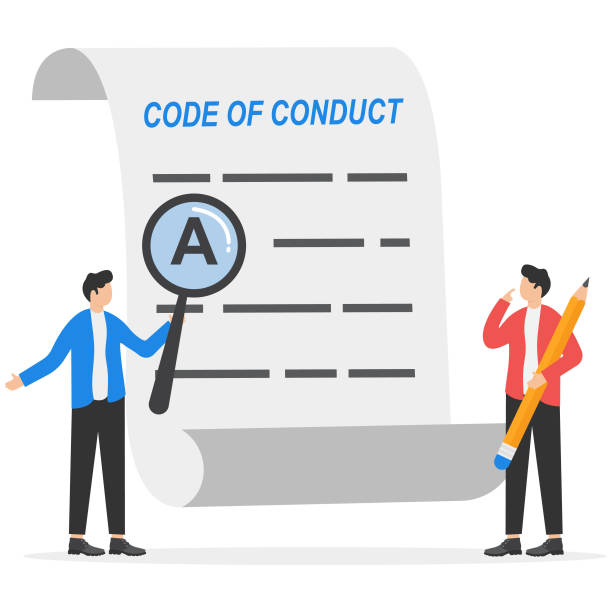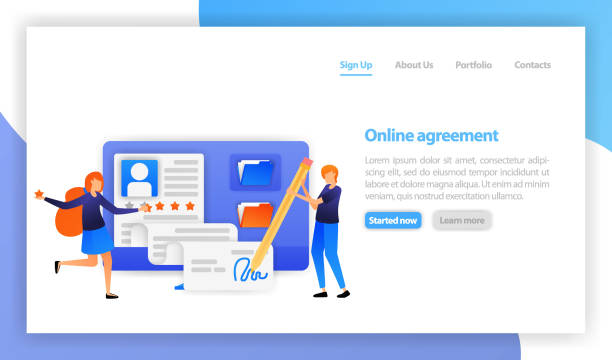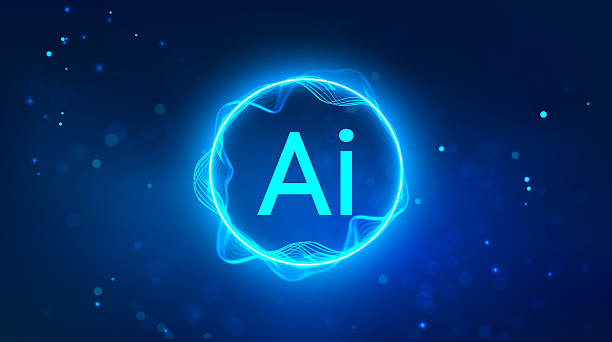Introduction to the Importance of Multilingual Website Design for Business Expansion

In today’s world, where geographical boundaries are rapidly blurring, a seamless and accessible digital presence for all users from different parts of the world is of vital importance.
#Multilingual_Website_Design is no longer a luxury option, but a strategic necessity for any business seeking international growth and expansion.
The main goal of designing such a website is to break down language barriers that can prevent global audiences from accessing your information, products, or services.
By providing content in users’ native languages, you not only significantly improve their user experience but also build a deeper sense of trust and connection with your brand.
This essential step opens new doors to global markets and provides unparalleled opportunities for expanding reach and increasing revenue.
This approach is particularly vital for companies planning to export their products or services or aiming to attract customers from all over the world.
From a digital marketing perspective, a website offered in multiple languages is considered a powerful competitive advantage that not only helps you increase your market share in different countries but also strengthens your brand’s credibility globally.
This section explains the necessity of this type of design.
Are you concerned about your e-commerce site’s low conversion rate and not achieving desired sales?
RasaWeb is your specialized solution for a successful e-commerce website.
✅ Significant increase in conversion rates and sales
✅ Professional and user-friendly design to ensure customer satisfaction
⚡ Ready for a transformation in online sales? Get a free consultation!
Unparalleled Competitive Advantages of Multilingual Websites in the Global Market

Multilingual websites, beyond addressing a simple communication need, bring significant competitive advantages to businesses.
Firstly, the most important advantage is the ability to access new markets and expand the customer base.
When a website is offered in different languages, you will be able to reach customers in geographical regions who were previously outside your sphere of influence due to language barriers.
This directly leads to increased website traffic and, ultimately, growth in sales and revenue.
The second important advantage is improved SEO and search engine rankings.
Search engines like Google prioritize websites that provide high-quality and relevant content in multiple languages in search results for users of that language.
This means increased visibility and easier discoverability by potential customers in target markets.
Thirdly, multilingual websites contribute to #increasing_user_trust and brand credibility.
When a company strives to present content in the audience’s native language, it demonstrates respect for their culture and language, which in turn builds a sense of loyalty and trust in customers.
This is a comprehensive analysis of the strategic advantages of multilingual website design.
Challenges Ahead in Designing and Implementing a Multilingual Website

Although the benefits of #Multilingual_Website_Design are numerous, its implementation also comes with specific challenges that require precise planning and specialized knowledge.
One of the biggest challenges is content management and the translation process.
Maintaining the quality and accuracy of translations over time and ensuring all language versions are up-to-date can be very complex.
This issue becomes even more critical for websites with dynamic and constantly changing content.
Another challenge involves technical and SEO considerations; optimizing the site for search engines in multiple languages includes the correct use of hreflang tags, appropriate URL structure for each language, and managing domains or subdomains, which requires high technical expertise.
Cultural issues must also be considered; simply translating words is not enough. Content must be adapted to the cultural nuances, idioms, and even colors and images of each region to prevent misunderstandings and ensure effective communication.
Furthermore, the continuous maintenance and updating of a multilingual site, both technically and content-wise, creates additional workload.
This specialized section addresses these challenges.
The table below compares common multilingual implementation methods in terms of their challenges:
| Implementation Method | Technical/SEO Challenges | Content Management Challenges | Maintenance Complexity |
|---|---|---|---|
| Subdomains (e.g., fr.example.com) | Requires DNS configuration, separate SSL certificate management | Requires multisite CMS or precise configuration | Medium to High (tool-dependent) |
| Subdirectories (e.g., example.com/fr/) | Easier SSL management, potential for URL structure errors | Generally easier with most CMSs | Low to Medium |
| URL Parameters (e.g., example.com?lang=fr) | Not recommended for SEO, might be ignored by search engines | Generally easy, but with SEO limitations | Low, but with SEO issues |
| Separate Domain (e.g., example.fr) | Requires purchasing separate domains, separate SSL management, distinct domain authority | Requires complex multisite CMS | High |
Choosing the Best Strategy for Implementing Multilingualism on Your Website

Choosing the right strategy for implementing multilingualism is one of the most crucial decisions in the path of multilingual website design, impacting SEO, user experience, and the ease of future site management.
There are three main approaches to structuring multilingual websites: using country-code top-level domains (ccTLDs) such as .de for Germany, using subdomains like fr.example.com, or using subdirectories like example.com/fr/.
Each of these methods has its own advantages and disadvantages.
Country-code top-level domains send the strongest geographical signal to search engines and can build trust with local users, but their management and maintenance are more costly and complex.
Subdomains are also a popular option, allowing search engines to understand each language as a separate entity, but you might need to create internal linking between them.
In contrast, subdirectories are usually the simplest and most cost-effective option and retain the full domain authority for all languages, but they might send a weaker geographical signal.
#Choosing_the_Right_Method depends on your budget, SEO goals, and current website structure.
This section provides practical guidance for informed decision-making.
Losing potential customers due to an unprofessional website? RasaWeb is your answer! With our specialized corporate website design services:
✅ Elevate your business’s credibility and standing
✅ Experience more targeted customer acquisition
⚡ Act now to get a free consultation!
Specific Technical and SEO Considerations in Multilingual Website Design

To ensure the success of a multilingual website in search engines, adhering to technical and SEO considerations is crucial.
One of the most important considerations is the correct use of the hreflang tag.
This tag informs search engines that different versions of a page exist for different languages or geographical regions, helping them display the correct version to relevant users.
Incorrect use of this tag can lead to duplicate content issues.
URL structure is also of paramount importance; URLs should be designed to clearly specify the target language and/or region, whether through subdirectories, subdomains, or top-level domains.
Furthermore, the site loading speed for each language version must be optimized, as slow speeds can harm user experience and SEO rankings.
Search engines are increasingly focusing on site speed and performance.
Also, using XML sitemaps for each language and ensuring proper crawling of multilingual content by search bots is essential.
#Technical_Optimization for multilingual websites is a specialized field that requires a deep understanding of search engine guidelines.
Success in multilingual website design heavily depends on adhering to these points.
Content Management and Translation Process in Multilingual Websites

One of the most complex aspects of multilingual website design is efficient content management and the translation process.
Choosing a Content Management System (CMS) that fully supports multilingualism is the first and crucial step.
CMSs like WordPress with suitable plugins (such as WPML), or Drupal and Joomla, which are designed for multilingualism from the outset, can facilitate this process.
After selecting the CMS, it’s time for the translation process.
Using machine translation is only recommended for non-sensitive and high-volume sections, but for main and strategic content, human translation by native and specialized translators is essential.
Translators must be proficient not only in the language but also in the culture and specific idioms of each region to ensure accurate and engaging translations.
Furthermore, a regular review and editing process must be in place to ensure the quality and consistency of content across all languages.
#Multilingual_Content_Management involves planning for content updates in all languages simultaneously or with a planned delay.
This educational section will help you implement successful strategies for managing your content and ensure that a consistent and high-quality message is conveyed to your audience in all languages.
User Experience (UX) and User Interface (UI) in Multilingual Website Design

User Experience (UX) and User Interface (UI) play a vital role in the success of a multilingual website.
UX/UI design in a multilingual website goes beyond merely changing the language and must consider #cultural_considerations and local user expectations.
One of the key elements is the appropriate placement of the language selection switch.
This switch should be easily visible and accessible, typically in the site’s header or footer.
Also, country flags should be avoided for displaying languages, and instead, language codes (e.g., EN for English) should be used, as a single language might be spoken in multiple countries, and flags can be misleading or even offensive.
The design should support Right-to-Left (RTL) for languages like Persian or Arabic, and Left-to-Right (LTR) for languages like English.
Fonts, text size, and even word length vary in different languages, and Responsive Design must account for these differences to ensure proper readability on all devices.
Icons and images should also be chosen to have a common meaning across all cultures, and symbols that might cause misunderstandings in some cultures should be avoided.
Finally, user testing with native speakers is essential to ensure a smooth and natural experience.
The table below highlights the differences between RTL and LTR design, which are crucial in multilingual website design.
| Feature | LTR (Left-to-Right) | RTL (Right-to-Left) |
|---|---|---|
| Text Direction | Left-to-Right | Right-to-Left |
| Element Layout (e.g., menu, form) | Main elements usually start on the left | Main elements usually start on the right |
| Navigation Icons (e.g., arrows) | “Next” arrow to the right, “Previous” arrow to the left | “Next” arrow to the left, “Previous” arrow to the right |
| Table and Chart Layout | First column (heading) on the left | First column (heading) on the right |
| Scroll Bar | Usually on the right | Usually on the left |
Continuous Maintenance and Updates for a Multilingual Website

After the completion of the multilingual website design process and its launch, the work does not end.
Continuous maintenance and updates are fundamental pillars of a multilingual website’s long-term success.
#Ensuring_the_Quality_of_Translations_Continuously and synchronizing them with the original content is one of the most important tasks.
Whenever new content is added to the original language or changes are made to existing content, it must be ensured that all language versions are also quickly updated and translated.
This continuous process can be managed through Translation Management Systems (TMS) or CMSs with advanced multilingual capabilities.
In addition to content, technical issues also require regular review and updates.
Ensuring the correct functioning of hreflang tags, monitoring broken links across all languages, and updating plugins and the CMS core to maintain security and optimal performance are among these items.
Furthermore, monitoring site performance in search engines for each language, through tools like Google Search Console, is crucial for identifying and resolving SEO issues.
This news section could also include announcements about new updates to multilingual platforms or innovative tools in this field.
Are you concerned about your e-commerce site’s low conversion rate and not achieving desired sales?
RasaWeb is your specialized solution for a successful e-commerce website.
✅ Significant increase in conversion rates and sales
✅ Professional and user-friendly design to ensure customer satisfaction
⚡ Ready for a transformation in online sales? Get a free consultation!
Measuring Success and Analyzing the Performance of a Multilingual Website

After launching and maintaining a multilingual website, the next crucial step is measuring its success and analyzing its performance.
For this purpose, using analytical tools like Google Analytics is essential.
With correct Google Analytics configuration, you can segment site traffic by user language and geographical region and see which language versions attract the most visitors.
Metrics such as bounce rate, time on site, pages visited, and conversion rate should be analyzed separately for each language.
This analysis helps you identify the strengths and weaknesses of each language version and optimize your strategies for improved performance.
For example, if the bounce rate is high in a particular language, it might indicate translation quality issues, irrelevant content, or UX problems.
Furthermore, reviewing SEO reports in Google Search Console for each language can help identify crawling or indexing issues.
#Data_Analysis in multilingual website design is an analytical process that enables you to make smarter, data-driven decisions for the growth and improvement of your website.
The Future of Multilingual Website Design and New Trends

The multilingual website design industry is constantly evolving, with new trends on the horizon that will shape its future.
One of the most significant trends is advancements in Artificial Intelligence (AI) and machine learning in translation.
While machine translation cannot yet fully replace human translation, AI-powered tools are becoming increasingly accurate and faster, serving as powerful tools to accelerate the translation process and reduce costs, especially for high-volume content or rapid updates.
Another trend is the expansion of “localization beyond language”.
This means fully adapting content, design, and even the shopping experience to local culture, including currency, dates, addressing, and even payment methods.
The rise of voice search and voice assistants also creates new challenges and opportunities for multilingual SEO, as users’ search behavior varies across different languages.
#The_Future_of_Multilingual_Web is moving towards smarter, more integrated platforms that allow businesses to access global markets with greater ease.
This engaging yet thought-provoking section allows us to consider how we can prepare to face these changes.
Frequently Asked Questions
| Question | Answer |
|---|---|
| What is a multilingual website? | It is a website whose content is available to users in several different languages. |
| Why should we design a multilingual website? | To expand reach to international audiences, increase site traffic, improve SEO in target markets, and provide a better user experience for non-Persian speaking users. |
| What are the main methods for implementing a multilingual website? | Using subdomains (e.g., en.mysite.com), using subdirectories (e.g., mysite.com/en/), and using separate domains for each language (e.g., mysite.com and mysite.de). |
| Which implementation method is better for SEO? | Generally, using subdirectories (language folders) is often recommended due to the transfer of main domain authority to other languages. |
| What is the Hreflang tag and what is its use? | It is an HTML tag or HTTP Header that tells search engines which version of a page is suitable for which language or geographical region. This tag prevents Duplicate Content and improves SEO. |
| How is a Language Switcher designed? | Usually by using a dropdown menu, button, or flag in the site’s header or footer, which allows the user to select their preferred language. |
| Is automatic (machine) translation suitable for a multilingual site? | No, machine translation usually has low quality and many errors that can harm the site’s credibility. Human translation or a combination of human translation and machine editing is recommended. |
| What are the most important SEO tips in multilingual website design? | Correct use of the Hreflang tag, having an appropriate URL structure for each language, translating titles and meta descriptions, translating core content, and internal linking between related language versions. |
| Should all website content be translated? | It depends on the strategy. Typically, the main and important content of the site should be translated. Less important sections or blogs may not require full translation. |
| What are the main challenges in designing a multilingual website? | Managing content in different languages, translation costs, technical issues related to URLs and language tags, template compatibility with Right-to-Left (RTL) languages like Persian and Arabic, and managing multilingual SEO. |
And other advertising services of Rasa Web Advertising Agency
Smart UI/UX: Revolutionize SEO ranking with the help of marketing automation.
Smart Customer Journey Map: A quick and efficient solution for campaign management focusing on custom programming.
Smart Digital Advertising: Transform digital branding with precise audience targeting.
Smart Marketplace: An innovative platform for improving customer acquisition with intelligent data analysis.
Smart Conversion Rate Optimization: A specialized service for growing customer acquisition based on user experience customization.
And over a hundred other services in the field of internet advertising, advertising consultation, and organizational solutions
Internet Advertising | Advertising Strategy | Advertorial
Resources
International SEO Optimization for Multilingual Websites
Best Content Management System for Multilingual Sites
Benefits of Multilingual Website Design
How to Implement a Language Switcher on a Website
✨ Let your business shine in the digital world with RasaWeb Digital Marketing Agency. We empower your digital identity by providing comprehensive services, including corporate website design.
📍 Tehran, Mirdamad Street, next to Bank Markazi, Kazeroon Jonubi Alley, Ramin Alley, No. 6




